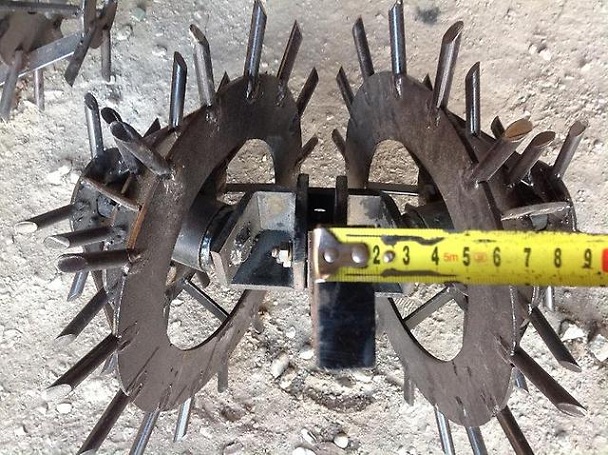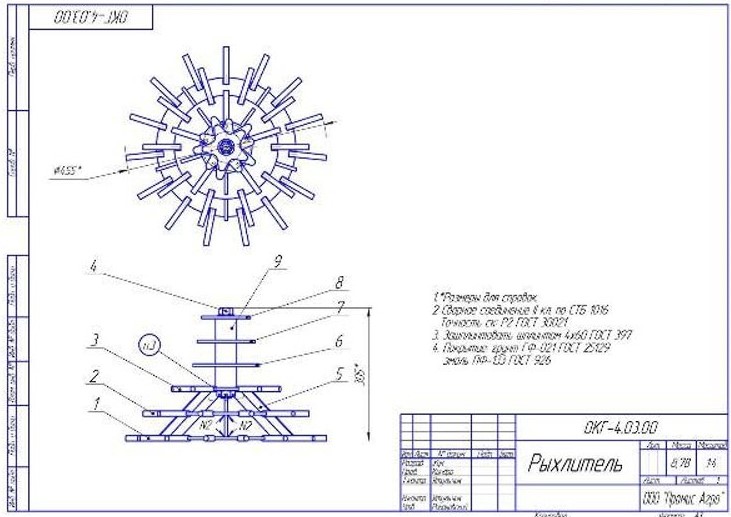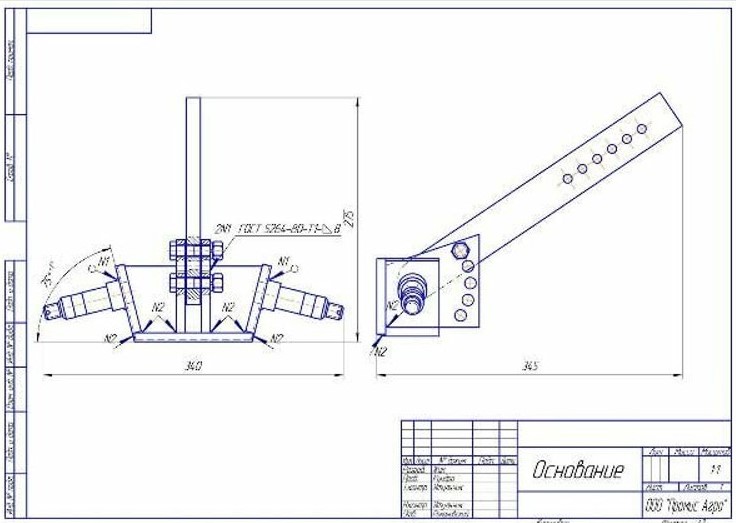How are hedgehogs for weeding potatoes made and why are they needed
The correctness and regularity of weeding the potatoes directly determines which tubers will ripen and whether the harvest will be rich. Every season, many gardeners use hedgehogs to weed potatoes, thereby saving their strength and tens of hours.
The content of the article
What are hedgehogs for weeding potatoes and why are they needed
Hedgehogs are an important agricultural tool, the main purpose of which is to save the time and effort of the gardener due to high-quality and gentle weeding beds with potatoes.
Together with the main function, they successfully loosen the soil and sprinkle the emerging seedlings, at the same time scaring off moles and other rodents in the cultivated soil.

What is their advantage
The advantage of hedgehogs for weeding potatoes, in addition to functionality, is the possibility of applying to all types of cultivators (manual, electric or gasoline).
This makes the tool suitable for use on small individual sites as well as on an industrial scale.
What are they
Despite the fact that the main function of all hedgehogs is the same, there are several types of such a tool, slightly differing in design.
Differences affect the effectiveness of the hedgehog on a site of one size or another.
For single-furrow potatoes
Single-furrow potato hedgehogs are designed for weeding small areas. The simplified design of this type of hedgehog facilitates the work of the gardener, representing a pipe 250 mm long, on which several discs with metal spikes 150-200 mm long are fixed.
Fastening is carried out by 2 bearings and a shaft. It is customary to hook this design to a walk-behind tractor to simplify work and save time when weeding potatoes.
For weeding potatoes on bearings
Bearing hedgehogs are designed for weeding beds with sizes from 60 to 90 cm. They are used immediately after germination and after ground tillage.
The advantage of this type of hedgehog is that they have a bearing unit, which provides additional fixation, as well as a 3-position adjustment of the weeding angle, which ensures high-quality loosening of the earth.
Rotary for weeding
The purpose of rotary hedgehogs is preliminary and post-emergence soil cultivation. These hedgehogs simultaneously plow and huddle the soil, while removing weeds. In this case, the size of the row spacing varies between 50-75 cm.
Processing potatoes with rotary hedgehogs is not a laborious process, since the rippers can be attached to any walk-behind tractor, cultivator and even a mini-tractor.
How to make hedgehogs with your own hands
Making hedgehogs with your own hands for a potato cultivator is a painstaking, but mandatory step to ensure the most comfortable use of the future tool.
The metal structure consists of 3 rows of discs of different diameters with metal spikes welded to them. The disks are connected to each other by special jumpers. The device is assembled on an inch pipe, inside of which there is a 20 mm fixed axle, attached to a bracket on the handle.
Necessary materials
You will need:
- steel sheets with a thickness of at least 4 mm for future discs;
- strip made of carbon steel with a width of 20 mm and a thickness of 4 mm for lintels;
- metal rods with a diameter of at least 8 mm and a length of 100-140 mm for thorns;
- pipe with a diameter of 250 mm for the frame;
- steel U-shaped bracket with a thickness of at least 4 mm and a width of 70 mm;
- a metal rod with a diameter of 20 mm, which is placed inside a pipe filled with grease, and the ends are inserted into the holes in the bracket.
Preparatory stage
At the preparatory stage of creation, you need to collect all the tools that will be needed in the process of making hedgehogs: a welding machine, a grinder, a metal cutter, and a set of locksmith tools. You should also prepare drawings of future hedgehogs (see examples below).
Step by step creation
Instructions:
- It is necessary to cut a piece from the steel pipe in accordance with the dimensions of the row spacing on the site.
- Cut 120 mm spikes from the rod and sharpen their edges by 45 °. On average, 2 hedgehogs require 75-90 thorns.
- Cut discs from sheet metal. The optimal diameters are 300, 200 and 100 mm. Cut holes for the pipe in these blanks. The hole diameter must be 1 mm larger so that the discs can be inserted and welded to the pipe.
- Modify the details with a grinder to eliminate burrs and irregularities.
- Spread the cleats evenly over the discs. On average, each requires 7-15 pieces.
- Bend the bracket on which the axle will be attached. The bracket can be either welded or drilled for bolt connections.
- Put the parts together. There should be a distance of 150-160 mm between the discs. Insert the ends of the axles into the holes of the brackets. Secure them with nuts or welding.
- Grinder all sharp corners and irregularities.
Drawings with dimensions and decoding
Drawing No. 1 shows a section of a hedgehog and its main parts:
- 1 - hitch;
- 2 - rotor (rotating shaft);
- 3 - cylindrical part of the rotor;
- 4 - a bracket that connects hedgehogs;
- 5 - the conical part of the rotor, on which the discs are fixed.

Drawing No. 2 shows the base of the hedgehog together with the bracket, as well as their optimal dimensions. The height of the fixture is 275 mm, the width is 340 mm, and the length is 345 mm. The rotor tilt angle is 75 °.

Drawing No. 3 shows a sectional view of a conical ripper:
- 1, 2, 3, 6, 7, 8 - discs with spikes;
- 4 - fixing bolt;
- 5 - a bar that connects the disks to each other;
- 9 - rotor.

How to use hedgehogs on a walk-behind tractor
Operating rules:
- Do not attach hedgehogs to the back of the walk-behind tractor, because in the event of an unforeseen impact, not only the base of the device, but also the walk-behind tractor can be damaged.
- Regularly clean the thorns of hedgehogs from weeds and soil.
- Use hedgehogs only in dry weather. Frequent contact with wet soil can cause rust. Treat hedgehogs with anti-corrosion agents at the end and before the start of each season.
- Only sharpen the lowermost part of the cleats. Otherwise, hedgehogs will cut the weeds, leaving the roots in the ground. For sharpening, use a grinder with the smallest abrasive wheels.
How to fix
Hedgehogs are attached to the walk-behind tractor using bushings and jumpers at an angle of 45 °.
To reduce the load on the attached structure, 2 guide wheels are installed. They can be reinforced with a bracket made of a metal strip at least 70 mm wide and 4 mm thick.
Reviews of experienced gardeners
Gardeners who used hedgehogs for weeding potatoes share their impressions.
Vitaly Panasenkov, Krasnodar: “I recommend buying hedgehogs for a walk-behind tractor in a special store. Otherwise, you will have to draw up a really competent drawing of the hedgehog, otherwise the weeding efficiency will be minimal. "
Anton Krasnov, Izhevsk: “Don't forget to paint your hedgehogs. This will save the wheels from rusting much better than any anti-corrosion agent. "
It is interesting:
What the potato trimmer attachment looks like and how to use it correctly
Detailed descriptions and effective treatments for potato diseases
The reasons for the drying of the tops and whether the potatoes grow after that
Conclusion
Hedgehogs for weeding potatoes are versatile equipment that is simply necessary for gardeners who want to significantly save time and effort. Hedgehogs have a simple design and a simple application algorithm.
Compliance with several important rules and careful operation will help the tool last a long time and provide a rich harvest.